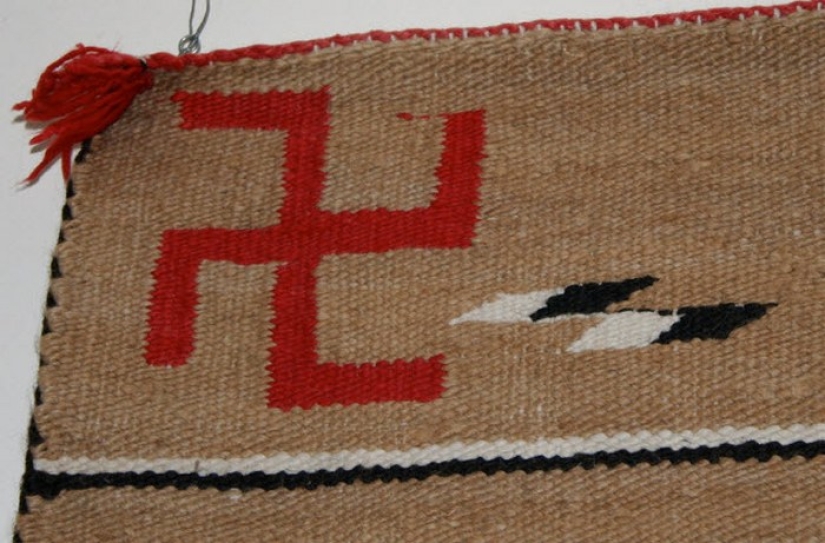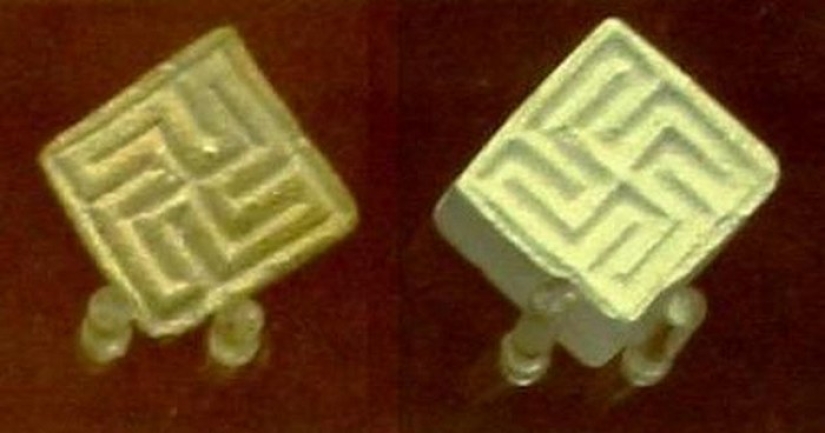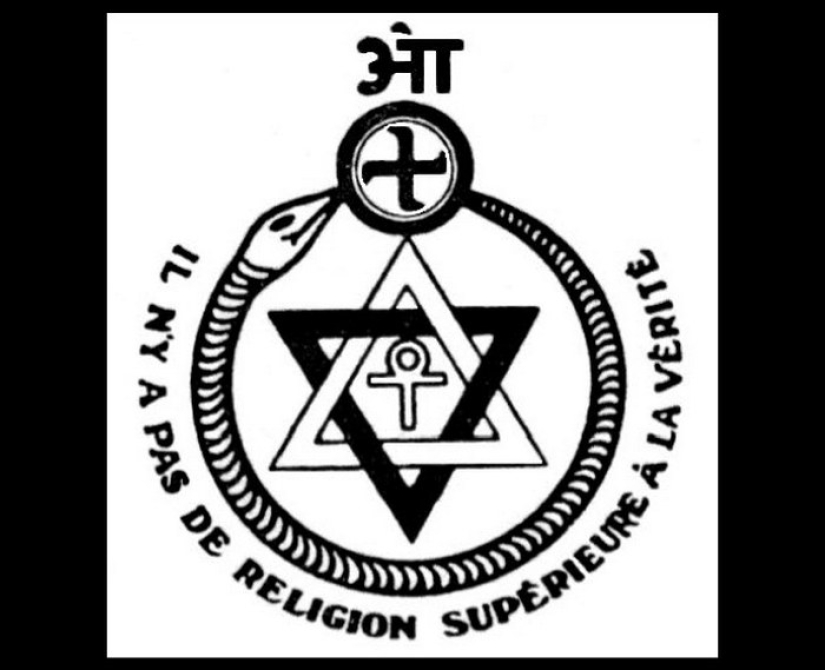10 examples of the swastika in different cultures that have nothing to do with the ideology of the Nazis
Categories: World
By Pictolic https://pictolic.com/article/10-examples-of-the-swastika-in-different-cultures-that-have-nothing-to-do-with-the-ideology-of-the-nazis.htmlThe swastika in the modern world is one of the most recognizable symbols of evil, racism and tyranny, which is still hated by people in many countries. However, in reality, the swastika has always been a symbol of good luck, used in many cultures before becoming associated with the murderous regime of the 20th century.
(Total 10 photos)
 Source: novate.ru
Source: novate.ru

1. Rotating log
Completely analogous to the Nazi swastika, the symbol known as the "spinning log" has been used by Native American Indians in the southwestern United States for centuries, beginning with the ancient Anasazi culture.
In Navajo mythology, this symbol depicts the story of an outcast traveling down a river in a hollow log. At the end of his journey, he reaches an abundant and prosperous land. In some cultures, a similar symbol represents the four winds or four directions.
After World War II, the Navajo, Apache, and Hopi Indians decided to stop using the swastika on their blankets, baskets, art, and clothing because of the association with Nazi evil. In recent years, the Indians are beginning to use this symbol again as a native Indian.

2. Gammadion
In ancient Greece, there was a symbol resembling a swastika, which was known as the gammadion. It resembled the four Greek letters gamma, which were aligned so that their corners formed a common center.
Early Christians used the gammadion to depict the cross of Jesus. It was also used as a secret symbol during the period when the Roman Empire was persecuting Christians. Some scholars claim that the gammadion symbolizes Christ and was used by early Christians to ward off the spirits of the dead in the catacombs. And long before the advent of Christianity, gammadion was found in almost all Mediterranean civilizations, such as the ancient Minoans, Greeks and Etruscans.

3. Van
In Buddhism, the swastika (called "wang" in Chinese and "manji" in Japanese) was an important religious symbol that signified the release of the spirit. Swastikas of different colors had different meanings: blue symbolized the eternal benevolence of heaven, red - the infinite kindness of the Buddha, yellow - eternal prosperity, and green meant unlimited perfection.
The left-handed swastika is considered the first of the 65 auspicious symbols of the Buddha, and the right-handed is considered the fourth of such symbols. In the Tibetan Bon tradition, the swastika is called gyung-drung, which means "eternal and unchanging". Unlike other swastikas in Hindu, Buddhist and Jain traditions, the Bon swastika is counterclockwise. In Chinese, the hieroglyph in the form of a swastika "ten thousand" means descent from heaven. In later times, this hieroglyph began to mean "many".

4. Gahuli
The traditional creed of the Jains was the swastika, known as the "gahuli", which symbolized the four dots, the four different destinies that each soul would encounter over several lifetimes depending on their deeds and karma: life as a human, animal, divine being, and hellish entities.
The swastika itself has several meanings. It is a wheel, symbolizing the eternal nature of material existence. The four branches represent the four branches of the Jain faith: sadhus (monks), sadhvis (nuns), shravakas (men), and shravikvas (women). The symbol reminds the Jains that their goal is liberation from reality, not rebirth in it. This can only be achieved through these four pillars of the Jain community. The branches also represent the four eternal characteristics of the soul: knowledge, perception, happiness and energy.

5. Swasti
In the Vedic tradition of ancient Hinduism, the word swastika comes from the word "swasti", which means "let only good things happen" or "well-being". This word was used to denote beauty and auspicious conditions, and was also included in farewell and congratulation rituals. Its origins are thought to be in the Indus Valley civilization's sun-worshipping religion, but the swastika was later incorporated into all currents of the developing Hindu faith.
The four branches of the Hindu swastika have many meanings: four Vedas, four goals of life (leading to prosperity), four stages of life (symbolizing good luck), four directions in space (meaning the omnipresence of Brahma), four seasons (meaning the cyclical nature of time) and four Yugas of the world cycle (meaning the natural evolution of the Universe). The swastika is closely associated with the god Ganesha, who is often depicted sitting on a lotus flower above the bed in the form of a swastika.

6. Khakaristi
The swastika, known as hakaristi in Finland, has been considered a symbol of good luck in Scandinavia and the Baltic region for many thousands of years. The Swedish nobleman Count Erik von Rosen considered this symbol a personal symbol of good luck, marking his luggage with it when traveling in South America and Africa. After Finland declared its independence during the Russian Civil War, Rosen actually pioneered the use of the swastika in the Finnish Air Force. In 1918, the blue swastika on a white background was adopted as the official symbol of Finnish aviation.

7. Emblem of Fohat
Theosophists have used the swastika symbol in various cultures and time periods throughout history. Madame Helena Blavatsky believed that the swastika was the emblem of Fohat, or cosmic electricity. Cosmic electricity is an occult Tibetan term for Daiviprakriti, the primordial light. In esotericism, it symbolizes the same thing - the universal life force.
Modern theosophical societies use the right-handed swastika as a symbol of the dynamic forces of creation, representing the global process of development, and also believe that the reverse swastika, which was used by the Nazis, is a symbol of the destructive forces leading to the end of the world.

8. Kipling's literary stamp
Many of the early works of the British writer Rudyard Kipling were emblazoned with the swastika symbol. He first began using the symbol on his book covers in the late 19th century after becoming familiar with the swastika in Indian art. Both types of swastika (clockwise and counter-clockwise) appeared on his works, symbolizing good luck. Along with the swastika, Kipling often used the image of an elephant's head as a tribute to the Hindu god Ganesha. At the same time, Kipling despised the Nazis.

9. Filfot
The term, which was originally used for the swastika symbol, has featured in various cultures across Europe. Some researchers associate it with the symbol of Thor's hammer, which may explain its presence on church bells in areas of England such as Yorkshire and Lincolnshire, which were influenced by Norse culture. This symbol is sometimes referred to as "Thor's hammer sign" or "Thor's cross".
The possible meanings of the four branches of the swastika are the seasons (winter solstice, spring equinox, summer solstice, autumn equinox), seasons (winter, spring, summer and autumn), phases of life (birth, life, death and rebirth), phases of the day (night, morning , day and evening), the elements (air, fire, water and earth), the phases of the moon (lunar eclipse, rising, full moon and waning) and the main directions (north, east, south and west).

10. Raelian swastika
The founder of the alien cult, Rael, used a controversial symbol in his movement - a combination of a swastika with a star of David. He claimed to have seen this symbol on the hull of the ship of the Elohim, aliens from outer space. The Star of David allegedly symbolizes infinity in space, while the swastika symbolizes the infinity of time. The general symbol denotes the relationship between time and space, eternity and infinity. All Raelites wear a medallion bearing this symbol.
Recent articles

The basis of almost all classical works based on real cases. The author had to do was skip the story through the prism of their ...

The ancient mythology of England, Scotland, Ireland and Wales is multifaceted and bizarre. Local tribes and peoples, as well as ...
Related articles

The characters in this collection know and have seen everything. But not all people know about their origin and meaning. Offer a ...

I use double exposures to blend two realities, capturing authentic moments from Bulgaria without digital edits. My technique ...

The sights of different countries are not only works of art, famous paintings, architectural objects, but also dishes. Croissants, ...

For many, hollow chocolate figures were a serious disappointment in childhood. A solid-sized hare or Santa Claus turned out to ...